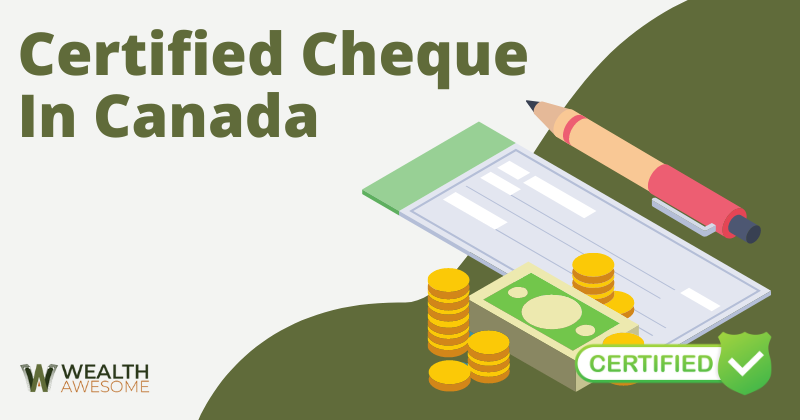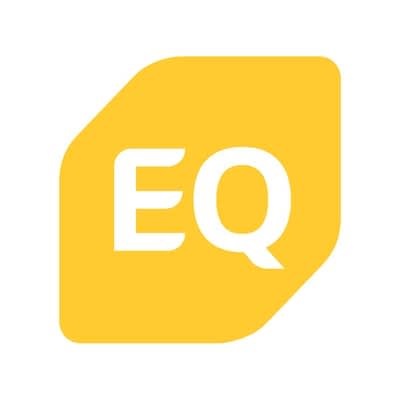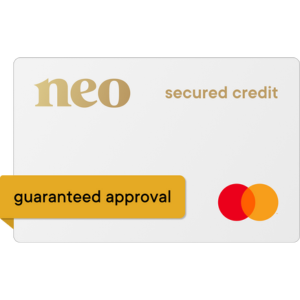Although certified cheques aren’t as common as they once were, you may still be required to provide one in certain rare circumstances.
Essentially, a certified cheque is a special type of cheque that proves to the recipient that you do, in fact, have the funds in your account to cover the amount written to the payee on the cheque.
Below, I’ll explain a bit more, show you how to get a certified cheque in Canada, and give you some examples of when you might need to write one.
What Is A Certified Cheque In Canada?
Certified cheques are a bit different from a traditional cheque that you write from your chequebook. Certified cheques are generally reserved for special purchases (usually high-dollar amount purchases) where trust is critical.
A certified cheque is a special cheque that has received your bank’s stamp of approval. In other words, your bank is verifying that you have enough money to cover the amount which the cheque is written for.
Additionally, the amount for which the cheque is written for will be set aside by the bank, ensuring that the amount cannot be withdrawn or used for another purchase.
Certified cheques in Canada must be directly obtained from your bank or financial institution. Most credit unions in Canada should also be able to provide you with a certified cheque.
How Do I Get A Certified Cheque In Canada?
Here are the four basic steps to follow if you want to get a certified cheque in Canada.
Step 1: Check Your Bank Account Balance
Traditional cheques can be written at any time, regardless of your account balance.
You could write somebody a $200 cheque and only have $50 in your account. The cheque would, of course, bounce and you’d have to pay a penalty. The recipient would not receive the money either.
To issue a certified cheque, banks must first verify that the funds are available in the account.
Double-check your balance to ensure that there’s enough money to cover the amount of the certified cheque.
Step 2: Visit Your Bank In Person
Certified cheques aren’t written from a chequebook. They must be obtained directly from your financial institution and are issued by bank tellers. This means that you’ll need to visit your bank in person and speak with a teller.
Step 3: Present Proof Of Your Identity & Account Ownership
As with any other bank withdrawal, you’ll need to prove that you are the account owner. This means you’ll have to present proof of your identity or hand over your debit card and enter your PIN number.
Step 4: Ask For A Certified Cheque
After verifying that the funds are indeed available in your account, your bank teller will confirm the amount that you want to write the certified cheque for.
Then, the teller will set the money aside in escrow, and create the certified cheque in the requested amount.
Why Would I Need A Certified Cheque In Canada?
Thanks to modern banking technology and secure money transfer services, certified cheques aren’t used very often today.
For that, I’m thankful. Certified cheques can be a bit of a headache to obtain since you have to schedule an appointment with your bank and make an in-person visit.
Periodically, though, you may be required to obtain a certified cheque from your bank. In most cases, certified cheques are only required when purchasing expensive items or handling professional negotiations. Some examples could include:
- Investing into or purchasing a business
- Buying a car, motorcycle, or recreational vehicle
- Making a down payment on a home or piece of land
- Purchasing an expensive piece of jewelry
- Purchasing a rare piece of art or collector’s item
When dealing with expensive items like these, you generally don’t want to carry cash, as the risk of theft is too great. Cash can also be lost; and when it’s lost, it’s gone for good.
If you accidentally lose a certified cheque, you can simply call your bank, explain the situation and your bank will void it to ensure that it isn’t fraudulently used.
Traditional Cheques vs. Certified Cheque In Canada: What’s The Difference?

All banks allow their customers to purchase cheques, which can be written at the account holder’s discretion.
The account holder simply needs to fill out a cheque with the recipient’s name, the amount being paid to them, and the date that the cheque is valid after.
The only problem is that traditional cheques can bounce (which is what happens when there aren’t enough funds in the account).
When the recipient tries to deposit a cheque, and it bounces, the recipient doesn’t receive the amount promised. At this point, the cheque issuer is informed of the bounced cheque and typically must pay a penalty fee. This leaves both parties unhappy.
Certified cheques are the solution to the problems that can arise from using traditional cheques.
When the cheque issuer requests a certified cheque from their bank, the bank sets the money aside as part of the verification process. Because of this measure, a certified cheque cannot bounce.
Bank Draft vs. Certified Cheque In Canada: What’s The Difference?
Like certified cheques, a bank draft is a negotiable instrument. Negotiable instruments are signed documents (as opposed to word-of-mouth agreements) that promise an agreed-upon sum of money to the receiver of the sum.
Negotiable instruments are generally considered safer than cash, as the latter can be easier to steal or lose.
So, what’s the difference between bank drafts and certified cheques?
The difference lies with the entity issuing the payment.
Certified cheques are issued by the account holder. The account holder visits their bank, requests a certified cheque, and has their banker set the money aside after providing a stamp of approval certifying the money is available in the account.
Bank drafts, on the other hand, are issued by the bank. When an account holder visits their bank and asks for a draft, the bank verifies the funds, and then directly sends the requested amount to the recipient’s bank account.
To send a bank draft from one bank to another, the sender must have the important details of the receiver’s bank account, including:
- The recipient’s full name
- The recipient’s banking details (account number, transit number, and branch number)
This means that the sender will usually request a void cheque from the recipient, to ensure that the funds are transferred to the correct account.
By contrast, a recipient can deposit their certified cheque into any bank account that’s attached to their name.
Bank drafts are generally considered a safer alternative to certified cheques, as the amount is only handled by the banks of the sender and receiver. Certified cheques must change hands, which, of course, introduces the possibility of loss or misplacement.
That being said, certified cheques do offer a bit more room for flexibility. Once a bank draft is sent, it cannot be unsent. If you decide to use a bank draft to pay for an item, you can’t back out at the last minute after you’ve paid.
Conversely, if you’re paying with a certified cheque, you could explain to the recipient that you’ve reconsidered, and return the cheque to the bank.
Cashier’s Cheque vs. Certified Cheque In Canada
When making an expensive purchase, cashier’s cheques are often accepted in place of a certified cheque. Cashier’s cheques can typically be obtained from a local wire transfer service location, which can be found in:
- Grocery stores
- Gas stations
- Convenience stores
The main difference between a cashier’s cheque and a certified cheque is that a cashier’s cheque must be paid for upfront with cash or debit funds. Conversely, a certified cheque is funded using money from your bank account that is set aside by your bank.
At this point, it may seem like semantics, but there is a difference nonetheless.
Generally speaking, a certified cheque appears more professional and is better suited for business negotiations, and other large transactions that you’d like your bank to have a record of.
Cashier’s cheques, while just as effective, don’t leave quite as much of a paper trail and are generally seen as more acceptable for paying utilities, rent, and other non-professional items.
Banks Offering Certified Cheques in Canada
If you need a certified cheque in Canada, you can get one from most major banks. Here is a list of banks that offer certified cheques and their fees:
- Scotiabank: $15 – $25
- TD Bank: $10 – $15
- BMO: $15 – $20
- RBC: No longer offers certified cheques, but offers bank drafts instead
- CIBC: No longer offers certified cheques, but offers bank drafts instead
How Long Does It Take To Receive Funds From A Certified Cheque?
Once the recipient deposits the certified cheque into their bank account, they should be able to access the funds within 2-3 business days.
Unlike cash, which is typically available immediately, cheques imply a transfer of funds from one institution to another, which can take a couple of days to process.
Do I Have To Pay For A Certified Cheque?
Yes, most banks charge a small fee for issuing a certified cheque. The amount charged depends on your bank and the amount that the cheque is written for. This makes them similar to money orders, which usually imply a $1 – $5 surcharge per money order.
Are Certified Cheques Safe?
Certified cheques are very safe, which is why they’re used in place of cash for large transactions.
In the unfortunate event that you lose your certified cheque before it can be given to the intended recipient, you can simply call your bank and cancel the cheque.
Certified Cheques Fraud and Risks
While certified cheques are definitely safer than meeting a stranger with cash, there’s still a small possibility of fraud.
With modern technology, clever scammers are able to produce fake certified cheques and use them to fraudulently “pay” for goods and services.
If you’re going to accept a certified cheque from a stranger or an individual you don’t trust, I recommend conducting the transaction at your bank.
This will allow you to deposit the cheque immediately, and verify that it’s a legitimate cheque before the other person disappears.
Risk of Loss or Theft
Certified cheques are like cash in that they can be lost or stolen. If you lose a certified cheque, you may be out of luck as they are non-replaceable. To prevent loss or theft, be sure to keep your certified cheques in a secure location and only use them when necessary.
Precautions to Take
To minimize the risks associated with certified cheques, there are some precautions you can take:
- Verify the authenticity of the cheque with the issuing bank before accepting it.
- Keep the cheque in a secure location until you are ready to use it.
- Use certified cheques only for transactions that require them, such as large purchases or real estate transactions.
- If you are the one issuing the certified cheque, make sure you have sufficient funds in your account to cover the amount of the cheque.
- If you suspect fraud, report it to the authorities immediately
Alternatives to Certified Cheques
If you’re looking for an alternative to certified cheques, there are a few options available. Here are some of the most popular alternatives:
Bank Drafts
A bank draft is a payment option that comes with a guarantee of the availability of funds. When a bank draft is issued, the financial institution guarantees payment to the recipient. Bank drafts are similar to certified cheques, but they are often used for larger transactions.
Money Orders
A money order is a payment option that is similar to a cheque. It is a prepaid payment that is guaranteed by the issuer. Money orders can be purchased at most financial institutions, and they are often used for smaller transactions.
Electronic Funds Transfer (EFT)
Electronic funds transfer (EFT) is a payment option that allows you to transfer funds electronically from one bank account to another. EFT is a fast and convenient way to make payments, and it is often used for larger transactions. EFT is a secure payment option, and it is often free or has a low fee.
Credit Cards
Credit cards are a popular payment option that can be used for a variety of transactions. Credit cards offer convenience and rewards, but they also come with interest charges and fees.
Conclusion

Certified cheques, while uncommon, are still used from time to time. That being said, there are safer, faster, and easier ways to send money. One of my favourite services that I use to transfer money is Wise.
Compared to other services, Wise charges incredibly low fees. Plus, the platform also supports foreign currency transfers, at a similarly low rate.
To learn more about Wise, you can read my full review here.





